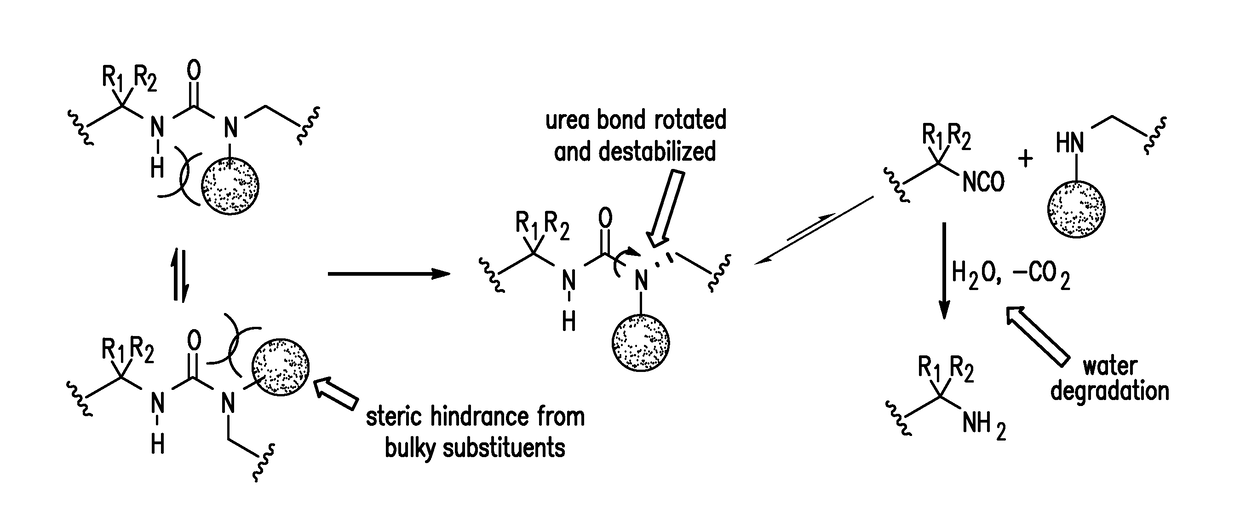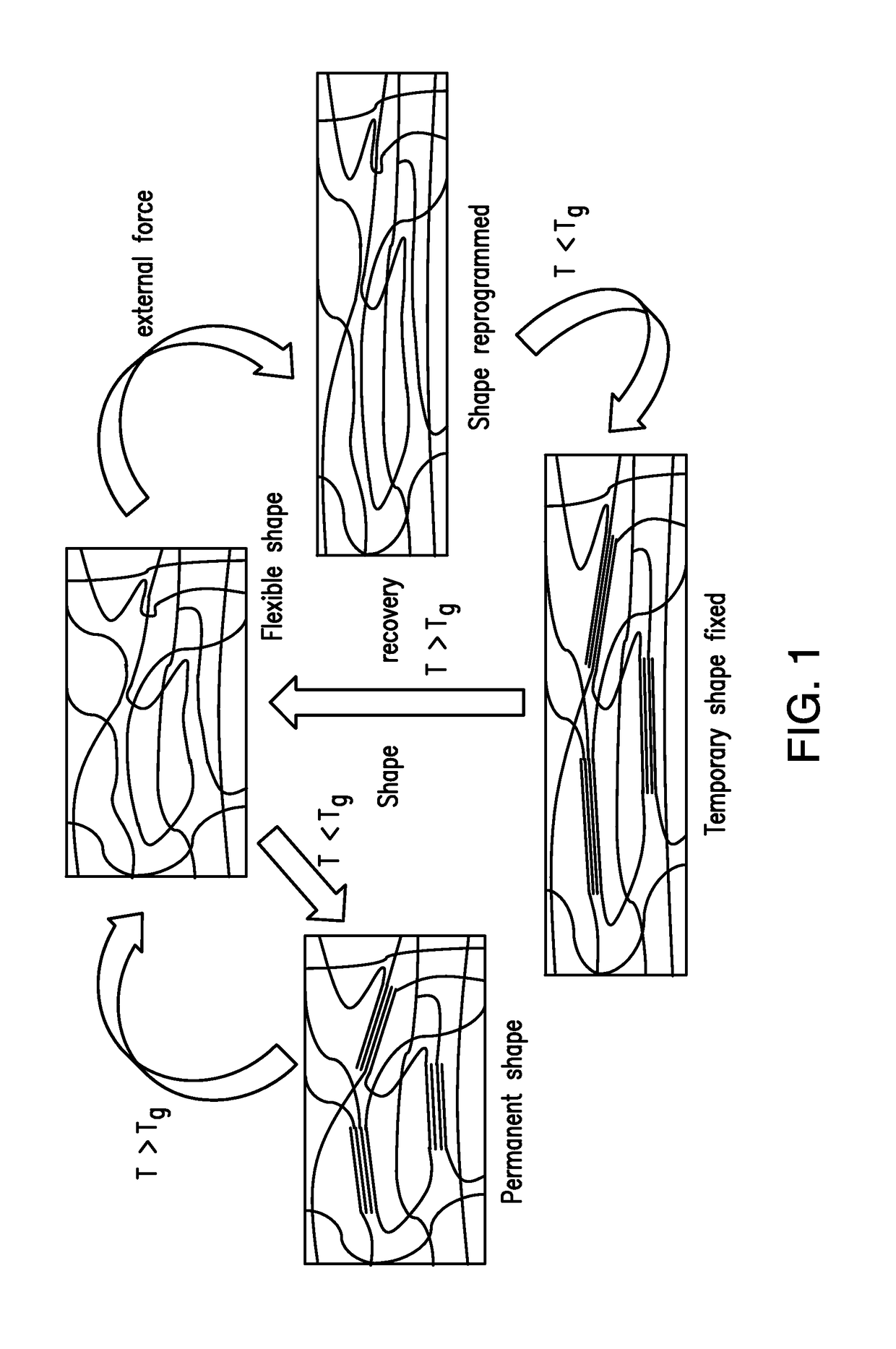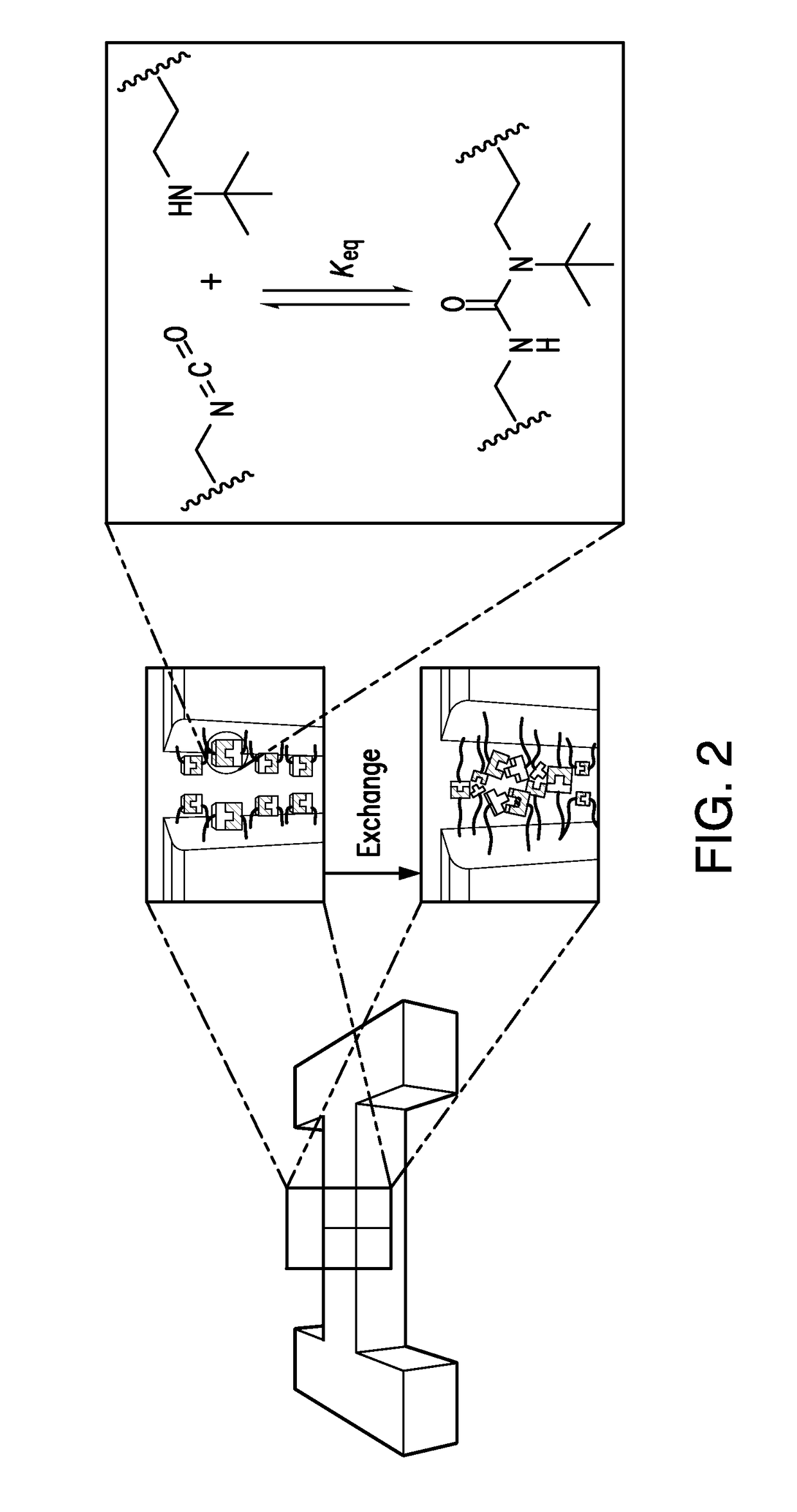Dynamic urea bonds for polymers
a technology of urea bonds and polymers, applied in the field of dynamic bonds of polymers, can solve the problems of many shape memory polymers, many polymers that do not have both the desired performance and dynamic characteristics, and cannot be processed, reprogrammed, or recycled
- Summary
- Abstract
- Description
- Claims
- Application Information
AI Technical Summary
Benefits of technology
Problems solved by technology
Method used
Image
Examples
example 1
ory Polymers
[0181]A HUB shape memory polymer was prepared from commercially available monomers: 2-(tert-butylamino)ethanol (TBAE) and tri-functional homopolymer of hexamethylene diisocyanate (THDI) in the presence of dibutyltin dilaurate (DBTDL) as a catalyst at 60° C. for 12 h. See the following reaction scheme.
[0182]The resulting cross-linked material has a Young's Modulus of ˜2 GPa. Due to the reversible nature of the HUBs, the cross-linked materials are still processible, which could be grounded to powders and molded into shapes such as films or dog bone specimens.
[0183]The HUB-SMP has a switchable domain with glass transition temperature at 53° C., which is also the temperature for triggering the shape memory behavior. The HUB-SMP was prepared as a straight band. After heating up to 60° C. (above Tg, the glass transition temperature), the band softened and became elastic. Using external force to deform the band and cooling the sample to room temperature with force applied, the ...
example 2
, Recyclable, and Healable Thermoset Polymers
[0185]A dynamic highly cross-linked poly(urea-urethane) network (PUU-TBAE) containing the corresponding HUB (1-(tert-butyl)-1-ethylurea (TBEU)) with a suitable binding constant (Keq=7.9×105 M−1) and disassociation constants (k−1=0.042 h−1, and 0.21 h−1 at 25° C. and 37° C., respectively) was prepared from commercially available monomers: 2-(tert-butylamino)ethanol (TBAE) and a tri-functional homopolymer of hexamethylene diisocyanate (THDI) in the presence of dibutyltin dilaurate (DBTDL) as a catalyst at 60° C. for 12 h. The polymerization reaction was confirmed by infrared spectroscopy, which revealed that the isocyanate end groups were consumed while urea or urethane bonds were formed. The resulting translucent polymer materials are hard and stiff at room temperature (Tg is ˜53° C.) and have a modulus of 3.5 GPa (analyzed by nanoindenter). Polymeric powders were obtained by grinding the bulk polymer using a pulverization machine.
[0186]We...
example 3
References for Example 3
[0205](1) (a) Petros, R. A.; DeSimone, J. M. Nat. Rev. Drug Discov. 2010, 9, 615-627. (b) Duncan, R. Nat. Rev. Cancer 2006, 6, 688-701. (c) Tong, R.; Cheng, J. J. Polymer Reviews 2007, 47, 345-381. (d) Yin, Q.; Tong, R.; Yin, L. C.; Fan, T. M.; Cheng, J. J. Polym. Chem. 2014, 5, 1581-1585.[0206](2) (a) Langer, R.; Vacanti, J. P. Science 1993, 260, 920-926. (b) Sun, H. L.; Meng, F. H.; Dias, A. A.; Hendriks, M.; Feijen, J.; Zhong, Z. Y. Biomacromolecules 2011, 12, 1937-1955. (c) Annabi, N.; Tamayol, A.; Uquillas, J. A.; Akbari, M.; Bertassoni, L. E.; Cha, C.; Camci-Unal, G.; Dokmeci, M. R.; Peppas, N. A.; Khademhosseini, A. Adv. Mater 2014, 26, 85-124. (d) Wang, Y. D.; Ameer, G. A.; Sheppard, B. J.; Langer, R. Nat. Biotechnol. 2002, 20, 602-606.[0207](3) (a) Ulery, B. D.; Nair, L. S.; Laurencin, C. T. J. Polym. Sci., Part B: Polym. Phys. 2011, 49, 832-864. (b) Lendlein, A.; Langer, R. Science 2002, 296, 1673-1676[0208](4) (a) Hwang, S. W.; Tao, H.; Kim, D. H.;...
PUM
| Property | Measurement | Unit |
|---|---|---|
| breaking strength | aaaaa | aaaaa |
| breaking strength | aaaaa | aaaaa |
| Young's modulus | aaaaa | aaaaa |
Abstract
Description
Claims
Application Information
 Login to View More
Login to View More - R&D
- Intellectual Property
- Life Sciences
- Materials
- Tech Scout
- Unparalleled Data Quality
- Higher Quality Content
- 60% Fewer Hallucinations
Browse by: Latest US Patents, China's latest patents, Technical Efficacy Thesaurus, Application Domain, Technology Topic, Popular Technical Reports.
© 2025 PatSnap. All rights reserved.Legal|Privacy policy|Modern Slavery Act Transparency Statement|Sitemap|About US| Contact US: help@patsnap.com



